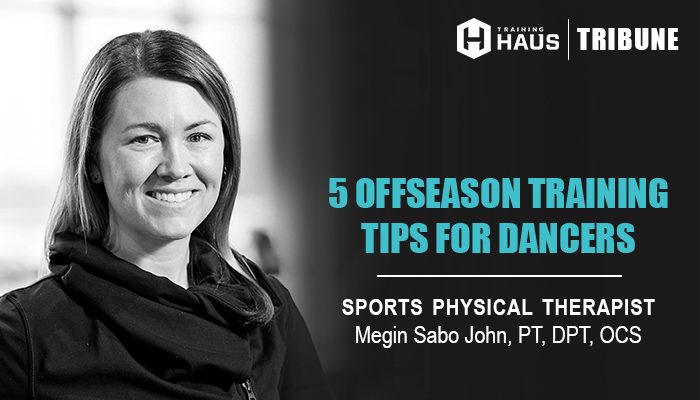
5 OFFSEASON TRAINING TIPS FOR DANCERS
Offseason training for dancers can be a great way to get ahead and prepare for summer intensives and next season. A well-rounded program should target various aspects of your training, including strength, endurance, flexibility, psychological readiness, and let’s not forget nutrition. We know that most injuries in dance occur in the lower extremities, although depending on your genre, upper extremity and back injuries are seen frequently as well. Let’s dive deeper on the above five training concepts and how you can work on developing these during your offseason training.
1. Strength
Designing a strength program can be fun and also dance specific. While it’s important to train both the upper and lower body, we are going to focus on lower body concepts. If you consider the impact to your hips and hamstrings with leaps, layouts, extensions, and kicks, you will want to include an eccentric training program for your hamstrings. This means you want to load your hamstring while you are lengthening them.
Adding in calf strength training is essential for turns, landing jumps, and pushing off during choreography. Turnout strength is a key in many dance styles, and we recommend resistance banded clamshells in a variety of positions from side lying, to hands and knees, and even standing. You can add rotational control exercises to help with quick choreography transitions and directional changes requiring complex hip motions. There are a variety of exercises you can implement, and we will show you a few in an upcoming social media post.
2. Endurance
Let’s consider your cardiovascular endurance. Often dancers train their performance pieces in small sections and only push their cardio output for 2-3 minutes at a time in class as well as on stage. Designing a workout for yourself can include bike, elliptical, and jogging as well as more intense bursts of jumping skills specific to your dance style. HIIT (high-intensity interval training) alternates short periods of training (30-90 sec of sprinting, jumping, or biking sprints for example) with recovery time.
Check in with your high school strength coach or a HAUS provider for tips on putting together an effective strength and endurance program.
3. Flexibility Training
Training your end ranges of flexibility should only be done after you are properly warmed up. Remember, stretching independently should never be considered a warmup. Flexibility training alone won’t allow you to hold your leg higher in the air, but it can give you a greater capacity of movement. As you focus on flexibility, consider the impact positions have on the rest of your body. If you feel pinch-type pain, you should adjust your positions, and while stretching isn’t comfortable, it should never be painful.
4. Psychological Readiness
This can involve many different aspects, including stress management, mindfulness, depression, and performance anxiety. You can utilize apps like Headspace for mindful meditations for beginners, sleep, and stress. Working with a sports psychologist can be beneficial for developing coping strategies, enhancing resilience, optimizing your mindset, and also your overall mental health. We rely on our partners at Premier Sport Psychology for assisting our athletes with individual sports psych sessions.
5. Nutrition
Fueling before dance is critical to having a successful practice. When a dancer correctly fuels their body before a rehearsal, they will have more energy, improved recovery rates, and a boosted mentality. Making sure to eat a meal or snack before exercising will keep your body fueled and your mind attentive to your performance.
Dancers should also plan ahead to keep snacks handy that will build lean muscle and sustain energy levels. Healthy snacks include yogurt, nuts/seeds, cheese, hummus, fruits and vegetables. Our Sports Dietitians advise:
- 3 to 4 hours before you exercise, eat a meal rich in carbohydrates with a small amount of lean protein and low fat. This could be a turkey sandwich with chips and fruit.
- 30 minutes to 1 hour before you exercise, eat a snack high in carbohydrates, moderate in protein, and low in fat and fiber. This could be cereal bars, a bagel with peanut butter, or a sports drink.
- Throughout the day, and the rehearsal/class, you should drink at least ½ your body weight in ounces of water to stay hydrated.
Conclusion
Here at Training HAUS, we are here to support dancers with a wide range of services and can design custom programs for individuals, small groups, and even for your dance team or studio. Please reach out to us at 952-456-7650 or email us at [email protected].
References
- Koutedakis Y, Hukam H, Metsios G, et al. The effects of three months of aerobic and strength training on selected performance- and fitness related parameters in modern dance students. J Strength Cond Res. 2007;21(3):808–812.
- Russell, JA. Preventing dance injuries: current perspectives. Open Acess J Sports Med 2013;4:199-210.
- Premiersportpsycology.com for Psychological Readiness content

